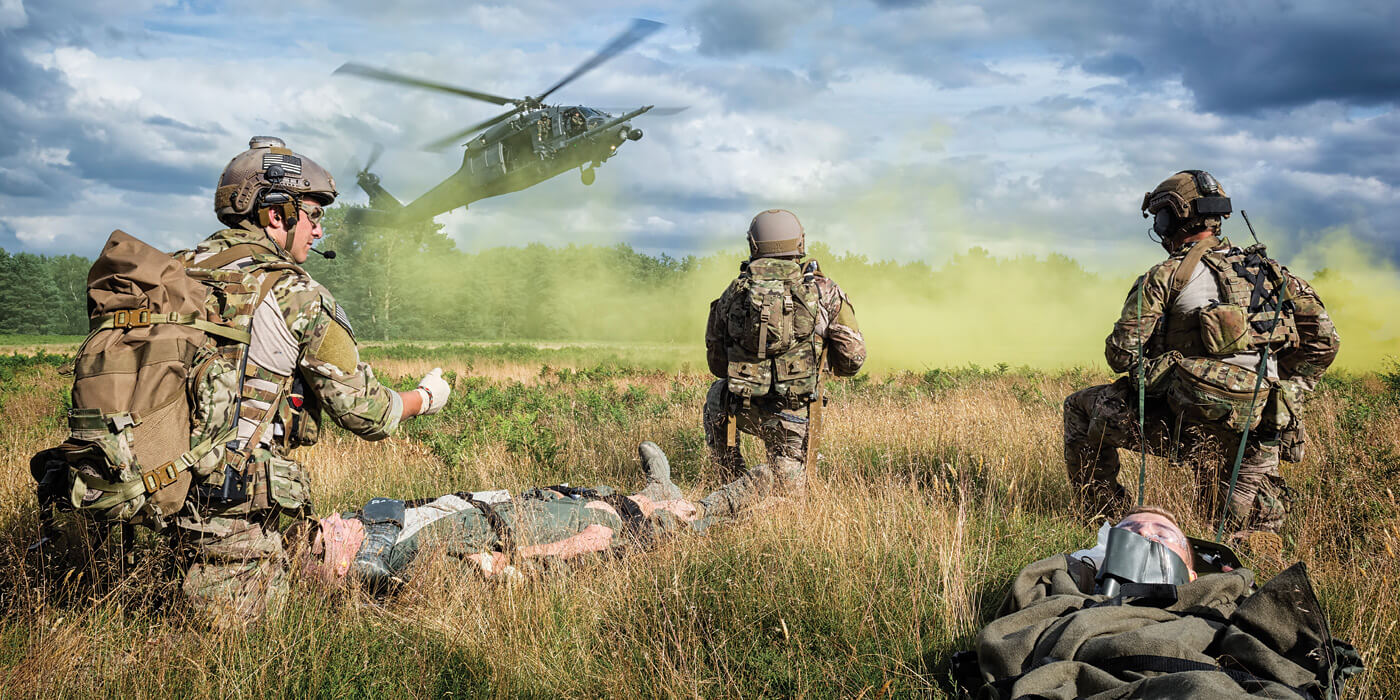Editor’s Note: Due to current threats, full names and titles have been avoided in this article in order to protect the security of United States Air Force personnel.
Combat search-and-rescue (CSAR) has to rank as one of the most iconic roles in aviation. After the British Royal Navy identified the necessity of rescuing downed aircrews during the First World War, the need for formal doctrine became apparent in the Vietnam War. This requirement was particularly highlighted by the rescue of Lt. Col. Iceal “Gene” Hambleton, immortalized in the film Bat*21.
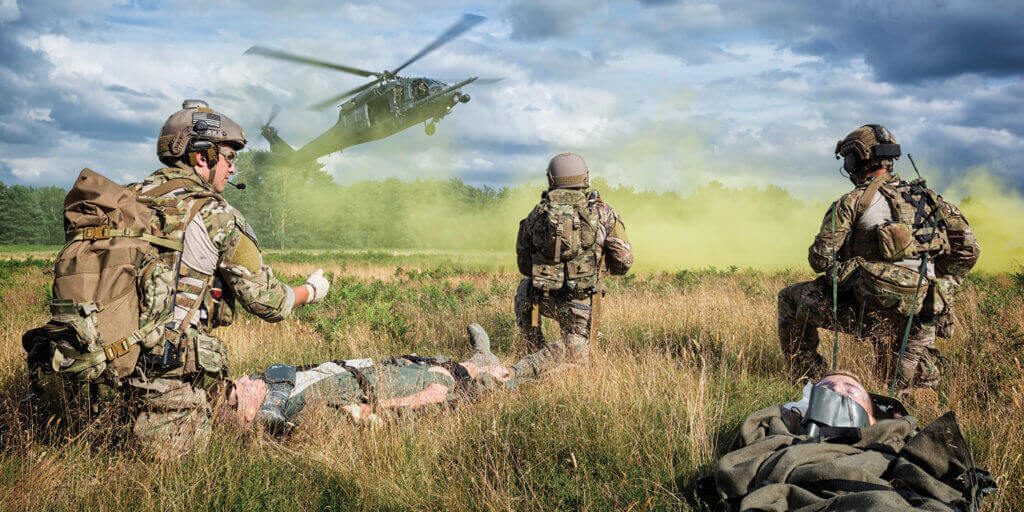
Based at Royal Air Force Lakenheath in Norfolk, Great Britain, the 56th Rescue Squadron (RQS) of the United States Air Force (USAF) provides its expertise across the European and African theaters, and is ready to deploy on operations far beyond. In 2015, the squadron was recognized as the top-performing USAF rescue unit, an accolade it retains today. Vertical 911 was offered exclusive access to the 56th RQS as the squadron trained throughout the summer of 2016, to see first-hand how the professionals go about what they call “personnel recovery.”
A Tradition of Service
Having been originally constituted in 1952 as the 56th Air Rescue Squadron, the unit flew a variety of types throughout southern Europe and northern Africa from Sidi Slimane in French Morocco before being discontinued in 1960. Re-activated in 1972 and deployed to Korat Air Base in Thailand, the newly titled Aerospace Rescue and Recovery Squadron was equipped with the unusually configured HH-43 Huskie — an intermeshing-rotor design by Kaman used for short-range overland SAR — and the Lockheed HC-130, with which the squadron took part in Operation Eagle Pull, the evacuation of Phnom Penh in Cambodia.
After its service in Far East Asia, the unit was again discontinued until 1988, when it was equipped with the HH-3E “Jolly Green Giant,” a moniker that is still close to the heart of the squadron. (The footprints of each member of the aircrews are printed in green paint on the ceiling tiles of the operations room, and the Green Giant adorns much of their unofficial badging.) In 1989, the unit reverted to its original title, before being re-designated in 1993 as the 56th Rescue Squadron.
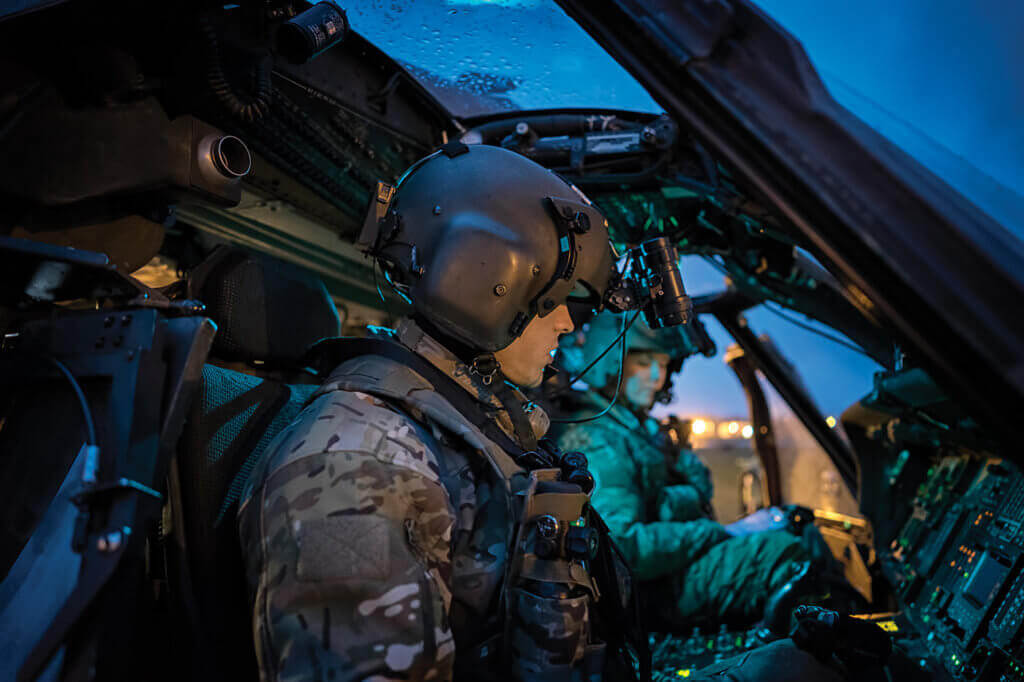
During this time, the unit provided SAR support to the Icelandic Defense Forces from a base at Keflavik, in Southern Iceland, with a search area in excess of one million square miles, reaching right up to the North Pole. Since 2006, however, the 56th RQS has been based in the U.K. From Lakenheath Air Base in the picturesque rural county of Suffolk in East Anglia, the squadron supports U.S. Air Forces Europe and Africa operations as part of the 48th Fighter Wing, the “Liberty Wing.” The squadron maintains readiness to deploy across these theaters and beyond, as it did in support of Operation Enduring Freedom in Afghanistan, and Operation Odyssey Dawn in Libya during 2011.
By the late 1980s, the venerable Jolly Green Giants were showing their age in an era of rapidly accelerating technology and an ever more expeditionary approach to warfare. While the USAF needed the capability to deploy rapidly and operate in an environment opposed by modern threats, the requirements implicit in executing combat search-and-rescue missions hadn’t changed a bit. The aircraft needed to be able to fight its way in and out of a rescue site, be tough enough to withstand enemy fire, and resilient against the elements. On top of all this, it needed to have the cabin space to receive casualties and house the equipment required to treat them, yet be small enough to fit into tactical air transport such as the C-130. The solution was found to be the Sikorsky UH-60A Black Hawk, already in service with the U.S. Army, and modified through a multi-stage program to meet the requirements of the USAF in the CSAR role.

The final result was the HH-60G Pave Hawk. “Pave” is the moniker given to USAF special-purpose electronics; the term here represents the significant upgrade to navigation and avionics systems in the aircraft. Inertial gyro, Doppler, and GPS-derived navigation systems were fitted in addition to secure radios and satellite communications. The cockpit was made night vision goggle (NVG)-compatible, with an additional forward looking infrared (FLIR) system fitted to the aircraft’s chin and displayed to the pilot on a look-down monitor. A weather radar completed the sensor fit, giving crews the ability to avoid the worst storms, while rotor anti-icing systems allowed certification for flight into known icing conditions, and the addition of an in-flight refueling probe gave additional range and endurance.
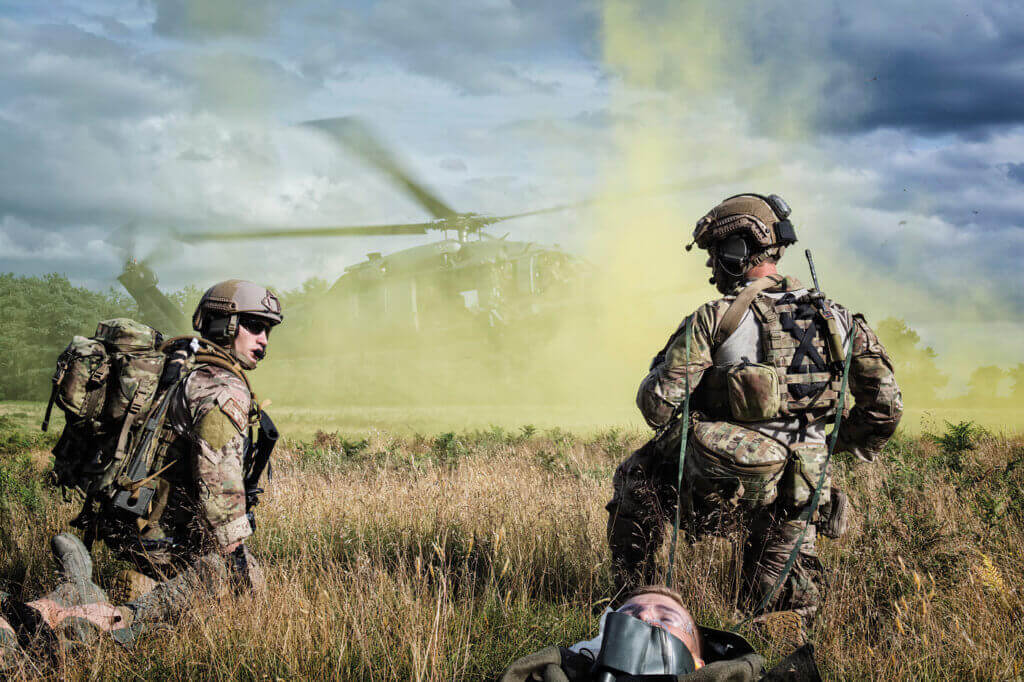
For defense of the aircraft, a radar warning receiver and missile approach warning system alert the crew in the event of attack from guided missiles, automatically scheduling the release of pre-programmed chaff and flare sequences. An infra-red countermeasure jammer may also be fitted. Offensively, the Air Force chose to replace the 7.62mm M60 machine guns fitted to the A-model Black Hawk with .50cal GAU-18A guns, while retaining the option to mount 7.62mm M134 miniguns instead — either one being a step up in firepower. The guns can either be fired by the two special mission aviators (SMAs) who work in the aircraft’s cabin, or locked into the forward position and boresighted to the aircraft’s nose, allowing the pilot to fire them electronically from the cyclic. This frees up the SMAs to carry out other duties in the cabin, and often they can remain secure while they do so, thanks to a modular track system that allows them to move their crashworthy seats around the forward area of the aircraft’s cabin, reconfiguring the seating arrangement on the fly.
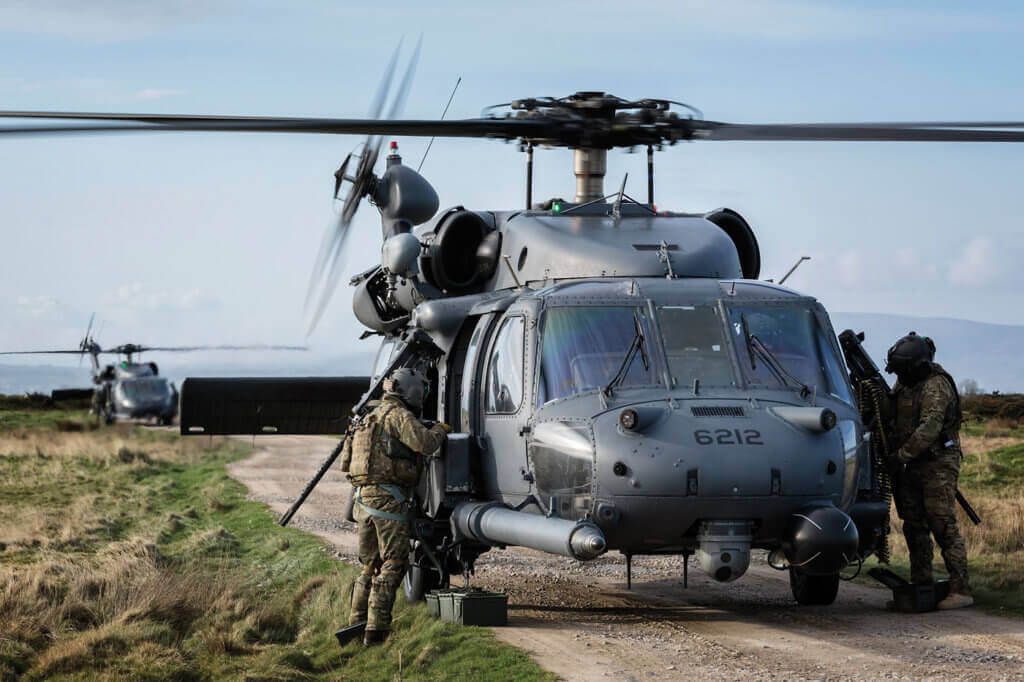
Space is at a premium in the back of the aircraft, and what real estate there is quickly fills up with pararescuemen and their associated gear. While the pilots and the SMAs are responsible for getting the aircraft to and from the scene of the rescue — the “terminal area” in CSAR parlance — the crux of the mission is the insertion and extraction of up to three other crew members on board. These are the pararescuemen, or “PJs,” whose job it is to get from the helicopter to the casualty and execute the rescue. This might mean receiving a casualty from troops on the ground, or it could mean locating isolated personnel in a contested area, recovering them from an immediately hazardous situation such as an aircraft wreckage, and finally stabilizing them and packaging them for rescue. PJs are also trained to administer life-saving medical care, including advanced techniques such as intraosseous infusion — in which a needle is drilled straight into bone to administer drugs and fluids in the fastest way possible. Along with all the medical equipment that the PJs may need, the interior of the aircraft rapidly fills with gear, including high-power rescue cutting tools.
“It looks like there’s a lot of room back there,” said “Shim,” a captain pilot and one of the 56th’s weapons instructors. “But once the PJ’s get in, they really like to take over.”
There are a variety of methods available to the PJs for getting out of the aircraft and safely onto the ground, as it’s not always possible to find a suitable landing site. The aircraft’s cabin floor has attachment points for rappelling (abseiling), or from which a rope ladder can be deployed. When greater speed of deployment is required, fast-ropes can be hung from lift webs across the cabin ceiling; however, this technique carries far greater risk of injury to the operators. Where these options are not appropriate, or where the helicopter cannot be safely hovered, PJs are trained to deploy by parachute. In early 2015, the 56th RQS PJs were split from the squadron and established as the 57th RQS, which brought them into line with the structure standard to the rest of the USAF.
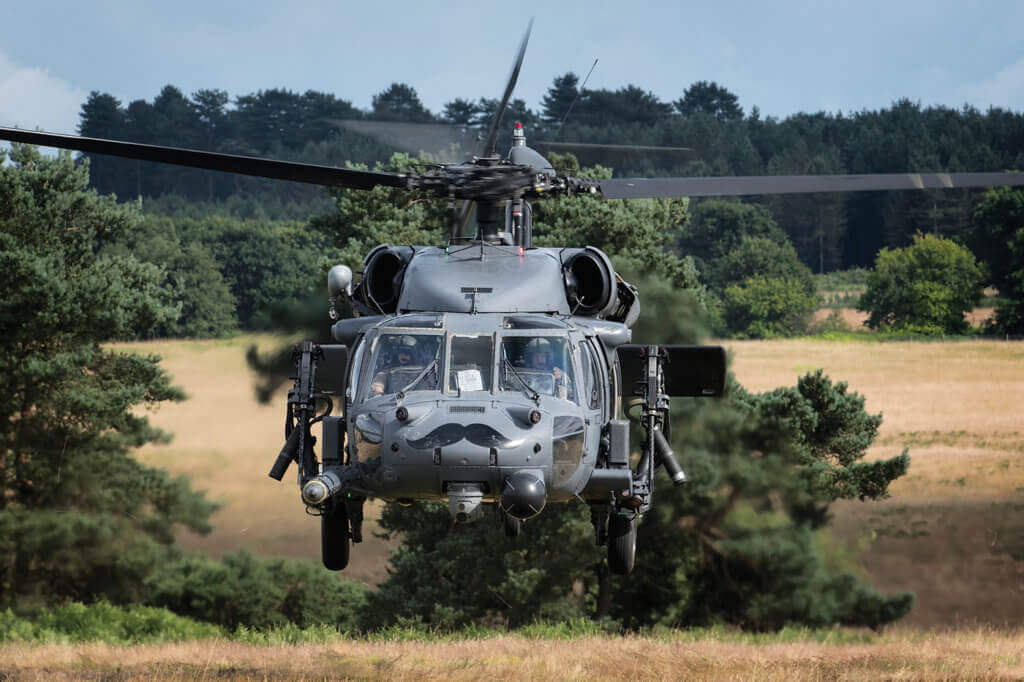
As ‘Shim” and I walked away from an HH-60G, I couldn’t help but ask about the cartoon moustaches painted on the nose. “From Afghanistan,” he explained. “Our call sign was ‘Pedro,’ so all the tails [airframes] got a commemorative moustache — they’re all different styles.”
Training for the Mission
The 56th Rescue Squadron’s high operational tempo demands the capability to operate in a variety of theaters and from a variety of locations, as was the case in Libya, where the squadron flew from the deck of the American warship USS Ponce. This means constant training and a commitment to make that training as realistic as possible. Vertical 911 was fortunate to be invited along as the squadron took part in Exercise Joint Warrior — the largest military exercise in Europe — and conducted a variety of local training sorties over summer that culminated in a large personnel recovery exercise.

In that final exercise, two “casualties” were placed in separate locations in the Stanford Training Area nearby, simulating ejectees from a Boeing F-15E. One was assumed to be injured or incapacitated as he had not made contact with friendly forces. His buddy had, however, and reported hearing voices nearby and seeing a vehicle driving up and down a road in the vicinity — time was clearly of the essence. With two other F-15E Strike Eagles in the air and two Fairchild Republic A-10C “Warthogs” also available, the 56th RQS launched a pair of Pave Hawks with PJs on board to effect the rescue.
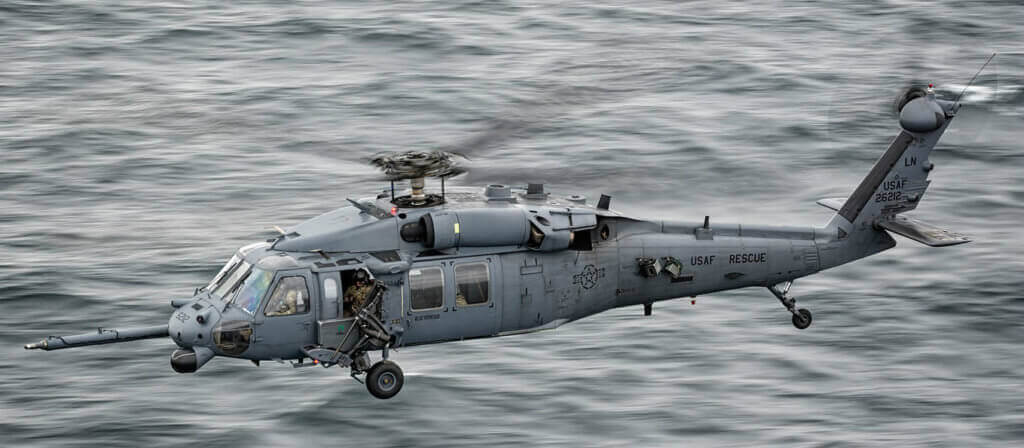
As they arrived in the terminal area, the F-15Es were able to declare the enemy vehicle as hostile, and simulate destroying it with precision guided munitions. The helicopter crews were able to identify a landing area from which to deploy the PJs and their associated gear. At the critical point, their radios burst into life and the workload ramped up as the crew worked the radios to avoid becoming task-saturated at a critical moment. After the PJs exited the aircraft, they were soon engaged by the simulated enemy forces — who were armed with marking ammunition for increased training value — and as they fought their way to the casualties were able to call on .50 caliber fire from the orbiting helicopters as well as support from the always impressive A-10Cs. (In a real scenario, the ‘Hogs would bring withering fire from their 30 mm GAU-8 Avenger cannon, as well as white phosphorus rockets for instantaneous smoke screening as the casualties were packaged and loaded back into the Pave Hawk for extraction.)
Back in the ops room after the mission, the response to the difficulties faced during the insertion was sanguine. “That’s why we train, we have to be able to respond when things aren’t going to plan,” said Major Uberuaga. As the squadron’s director of operations, Uberuaga shoulders the responsibility for core business, and his passion to see the unit grow and improve is tangible. “Since Vietnam, the mission philosophy has really developed,” he observed. “And we have developed much better tactics in the terminal area, resulting in better weapon effectiveness and greater safety, with the upshot of a far lower chance of suffering losses.”

Indeed, in Afghanistan attrition was much lower than anticipated, and the Pave Hawk crews found themselves being tasked with an increasing number of casualty evacuation and medical evacuation missions as a result.
Looking to the Future
In 2017, the 56th RQS is programmed to leave the U.K. for Aviano Airbase in Italy. Uberuaga said the squadron will be sad to leave Britain, but he’s upbeat about the future.
“As well as supporting combat search-and-rescue tasking, we provide a lot of expertise in personnel recovery to partner nations throughout the theater,” he explained. “Being south of the Alps will mean that we have a much more central location, and we will be less reliant on strategic airlift, which will mean a much shorter response time.”
Further into the future, the squadron expects to see HH-60Ls being introduced to replace operational losses, and beyond that they are looking forward to the next-generation HH-60W — which the USAF is referring to as the Combat Rescue Helicopter program, but which the operators have dubbed the “Sixty-Whiskey.” It will bring many improvements, not least of which will be a glass cockpit from Rockwell Collins to replace existing “steam” gauges, as well as Lockheed Martin’s mission planning suite.

Combat search-and-rescue has always been a subject of fascination for the media, whose portrayal, whether for reasons of expediency or incomprehension, is often one of airmen undertaking rescues no matter the odds, and without regard to the dangers. While the crews and PJs of 56th and 57th RQS are undoubtedly valorous, the reality is, unsurprisingly, far more nuanced. CSAR operations demand a clear-eyed acknowledgement of the risks involved. Their prime task, after all, involves recovering airmen downed by enemy action — a situation which in itself confirms the anti-aircraft capability of the opposing force in the precise area that the CSAR unit must operate.
This places a far greater demand on aircrews than simple courage. It involves the accurate assessment of a complex and rapidly changing situation, identification of the hazards involved, and application of the correct tactics, training, and equipment to mitigate the risks to the greatest extent possible. Ultimately, the story of CSAR is that of 14 lives weighed potentially against a single life — the life of the colleague they are there to save. The situation presents an almost inestimable pressure to which no-holds-barred heroism is no solution; thoughtless action will, at best, only add several more to the list of those in need of rescue.
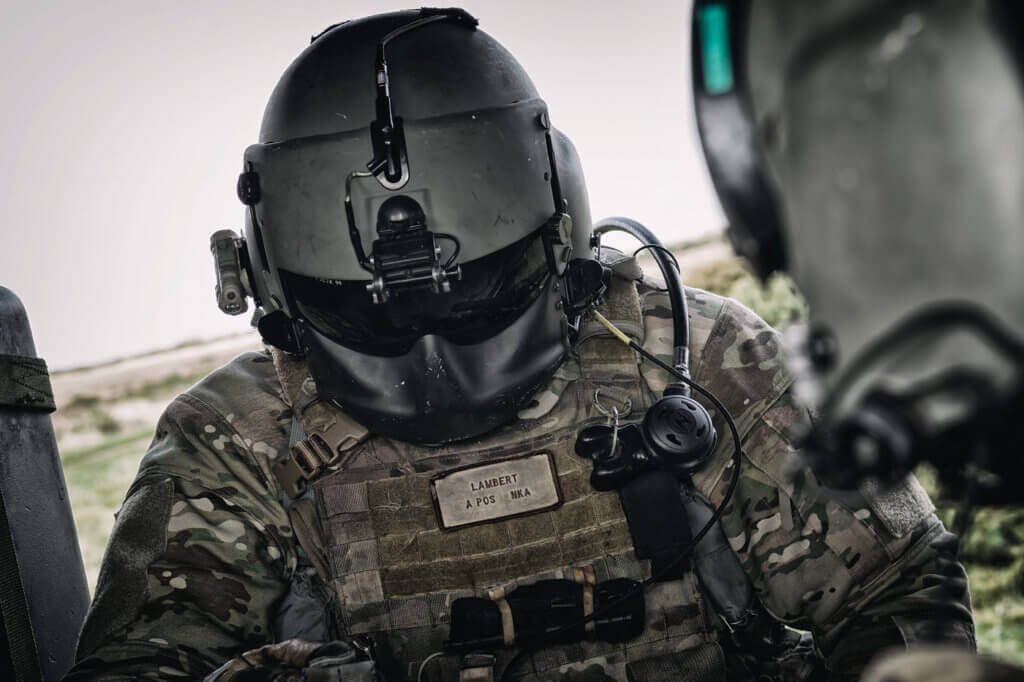
Instead, these aviators and PJs, some still in their early 20s, must consider numerous factors: the threat to their lives, the status of the casualty, the enemy’s capability and their own. They must communicate with the rest of their team and other supporting assets, employ weapons while remaining within their rules of engagement, apply complex tactics and, along with everything else, safely fly and operate a helicopter or carry out life-saving treatment.
Among this maelstrom of mental activity, stress, and the pressure that comes with immediate jeopardy, they must make the decision — one of life and death in the most real sense.
As a squadron member with responsibility to train young men and women to make these decisions, “Shim” was unequivocal in stating, “We can’t use a matrix-based, situational approach. No two rescues are the same, we need that flexibility. As long as you can accurately identify and assess the risks, you’ll make a good decision regardless of the precise situation.”
So in those situations, under that stress, is it possible to enjoy his job? “Absolutely,” was his unhesitating response. “Combat SAR was always a vocation for me, because bottom line, it’s about helping people, no matter who they are. Whether you agree with the politics, the reasons for being there or not, you’re there to save lives. That is always honorable.”





